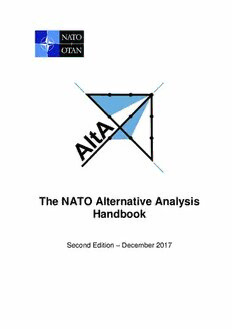Table Of ContentThe NATO Alternative Analysis
Handbook
Second Edition – December 2017
The NATO Alternative Analysis Handbook
Second Edition, December 2017
© NATO. This handbook is distributed free of charge for informational and educational
purposes. Copies can be obtained on request, subject to availability, by emailing al-
[email protected] or [email protected]. The sale and reproduction of this handbook for
commercial purposes is prohibited. Extracts may be used for bona fide educational and
informational purposes subject to attribution to NATO.
ISBN (PDF Version) 978-92-845-0208-0
Foreword
The Alliance relies on thoroughly considered and well-implemented plans, policies, and
procedures taking into account the unique political, strategic, and operational issues it
faces daily. The processes of their development however necessarily drive towards a
consensus opinion for numerous reasons, often at the expense of unique or divergent
perspectives. Applying independent critical thought to such problems offers the decision
maker a broader view of the situation, a comprehensive understanding of the problem,
and can expose unforeseen implications that are the cause of failure of otherwise well-
considered solutions.
Alternative Analysis (AltA) is a widely-applicable capability that supports the inclusion of
independent, critical thought and alternative perspectives that is essential for informed
decision-making. It offers NATO staff the opportunity to inject additional knowledge – or
knowledge perceived in a different way – into established decision-making processes
alongside traditional problem-solving methods. In general, AltA reduces risk and ex-
pands opportunities for innovative solutions, creating space for more timely decisions.
AltA provides a credible solution to tackling the current and future challenges of this ex-
tremely complex and fast-changing world.
AltA comprises of a set of techniques that can be learned and put into practice by any
NATO staff officer. The techniques were not invented by NATO, but are rather
specifically chosen for NATO from a wide range of business and intelligence analysis
practices. They are applicable to many different situations and are therefore techniques
that staff officers will use throughout their careers. These techniques are complemented
by an AltA training course held at NATO School Oberammergau and an active communi-
ty of AltA facilitators.
As a comprehensive guide to AltA, this NATO Handbook constitutes a critical building
block for project or planning work at any level of staff across the Alliance. It is specifically
designed to be used as a quick reference guide for staff to assist in diagnosing prob-
lems, understanding complicated situations, creating innovative solutions, challenging
plans, and making decisions. It is applicable to almost any subject or situation, indeed
many examples of its use on real-life NATO problems across Allied Command Opera-
tions and Allied Command Transformation have been included in this handbook.
This handbook consists of three parts: (1) an introduction to AltA, (2) the set of AltA
techniques, and (3) facilitation best practices. It concludes with a bibliography and glos-
sary. Any questions about AltA or this handbook should be referred to [email protected]
or [email protected].
44
vVl1 ..
Air Marshal Sir Graham Stacey Lieutenant General Hugues Delort-Laval
This page is intentionally left blank.
Table of Contents
Part 1
Application of AltA
1 Alternative Analysis Explained ............................................................................................ 3
2 Motivation for Using AltA ..................................................................................................... 5
Common Problems of Decision-Making Processes ............................................................. 5
Biases ................................................................................................................................. 5
3 AltA Capability Principles..................................................................................................... 7
4 AltA Process ........................................................................................................................ 9
Initiation............................................................................................................................... 9
Preparation ......................................................................................................................... 9
Application ........................................................................................................................ 14
Termination ....................................................................................................................... 14
Part 2
AltA Techniques
1 Categories of AltA Techniques .......................................................................................... 17
2 Structuring Techniques ..................................................................................................... 19
Mind Mapping ................................................................................................................... 19
Concept Mapping .............................................................................................................. 24
Rich Pictures ..................................................................................................................... 27
3 Creative Techniques ......................................................................................................... 31
Brainstorming .................................................................................................................... 31
Reverse Brainstorming ...................................................................................................... 37
Brainwriting ....................................................................................................................... 40
Starbursting ....................................................................................................................... 45
Six Thinking Hats .............................................................................................................. 49
Creative Combinations ...................................................................................................... 53
4 Diagnostic Techniques ...................................................................................................... 57
Strengths, Weaknesses, Opportunities, Threats (SWOT) Analysis .................................... 57
Plusses, Minuses, Interesting (PMI) .................................................................................. 64
Page v
Five Whys ..........................................................................................................................67
Key Assumptions Identification ..........................................................................................71
Quality of Information Check ..............................................................................................76
Outside-In Thinking ............................................................................................................79
Surrogate Adversary/Role Play ..........................................................................................82
Alternative Futures Analysis ...............................................................................................85
5 Challenge Techniques .......................................................................................................91
Devil’s Advocacy ................................................................................................................91
Team A/Team B Analysis ...................................................................................................94
Pre-Mortem Analysis ..........................................................................................................97
What-If Analysis ............................................................................................................... 101
Part 3
AltA Facilitation
1 Facilitation Introduction .................................................................................................... 107
2 Facilitation Preparation .................................................................................................... 109
3 Facilitation Application ..................................................................................................... 113
Getting the Group Started ................................................................................................ 113
Asking Questions ............................................................................................................. 113
Using the Pen .................................................................................................................. 114
Maintaining Energy of the Group ...................................................................................... 114
Managing personalities .................................................................................................... 115
Closing the session .......................................................................................................... 120
4 Desirable Qualities for an AltA Facilitator ......................................................................... 122
5 Facilitation Summary ........................................................................................................ 124
Page vi
This page is intentionally left blank.
Page vii
This page is intentionally left blank.
Page viii
Part 1
Application of AltA
Page 1
This page is intentionally left blank.
2

